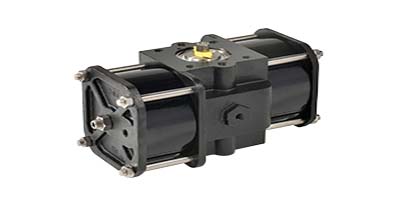PATENTED RACK & GEAR® MECHANISM
The T-Series actuator demonstrates how we are committed to making life easier. An OEM of over-the-road bulk carriers was impressed by the capabilities of our Rack & Gear® actuators and they appreciated our ability to mount to numerous valves simply by selecting the proper adapters and mounting plate. However, their application requires relatively frequent valve replacement (as well as the actuators they had been using) and their experience has been that small parts such as adapters are frequently lost during maintenance. Also, due to space issues, they had developed a special short mounting for accessories that were not compatible with the typical international mounting standards. In answer to their needs, we developed the T-Series which is based on the normal Q-Series Rack & Gear® design but has unique multi-mounting pattern bodies and made-to-purpose shafts that allow direct fit to their existing valve with no bracketry or adapters. Also, accessory mounting geometries were modified to suit their existing designs.
OFFSET CYLINDERS
The piston axis aligns with the pinion gear pitch circle diameter, eliminating the cantilever forces inherent in rack and pinion-type actuators. Low friction rollers maintain correct engagement of the stainless steel gearing for absolutely exceptional cycle life. The reduced friction enables outstanding throttling control as demonstrated in numerous ‘typical diaphragm actuator’ applications where corrosion or high vibration dictated a better solution.
BI-DIRECTIONAL TRAVEL STOPS
QS actuators feature bi-directional travel stops which allow a minimum of 5 degrees of overtravel in each direction. The stops act on the piston motion and impart no side loading on the shaft.
NON-PRESSURIZED SHAFT SEALS CAN NOT FAIL (SPRING RETURN)
QS series spring return actuators apply no pressure to the shaft seals, eliminating a common cause of rack & pinion actuator failure.
PRESSURE BALANCED SHAFTS
While QS Series Double Acting actuators pressurize the shaft seals on the return stroke, we use a pressure-balanced shaft design that is not subject to the high “pistoning” forces seen in typical rack & pinion actuators. Unbalanced shafts lead to higher friction, torque loss, and early failure.
NON-EXISTENT ROD SEALS CAN NOT FAIL
Locating springs inward of the pistons applies pressure to the outer piston surface eliminating the need for rod seals on spring return actuators.



